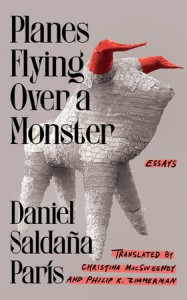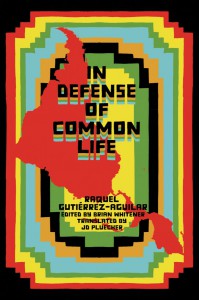In this month’s compilation of newly released titles, our editors take a close look at three works that cohere stylistic invention with unconstrained probings into reality. In a bold collection of psychogeography, Daniel Saldaña París vivifies the urban space as a transformative intersection of image and imagination. From Aimé Cesaire, one of the founders of négritude, an early dramatic work provides further insight into his potent discourse against colonial violence. And in the English-language debut of one of Latin America’s most vital political thinkers, a volume combining dialogue and essay introduces the essentiality of communal resistance in the thinking of Raquel Gutiérrez-Aguilar.

Planes Flying Over a Monster by Daniel Saldaña París, translated from the Spanish by Christina MacSweeney and Philip K. Zimmerman, Catapult, 2024
Review by Sofija Popovska, Editor-at-Large for North Macedonia
“The long poem of walking manipulates spatial organizations. . . It creates shadows and ambiguities within them. It inserts its multitudinous references and citations into them. . .” writes Michel de Certeau in his 1984 book, The Practice of Everyday Life. I thought of these words immediately as I immersed myself in the shifting landscapes of Planes Flying Over a Monster, a collection of ten essays by Daniel Saldaña París, translated from the Spanish by Christina MacSweeney and Philip K. Zimmerman. In writing about (and moving through) Montreal, Havana, Mexico City, Madrid, and other places, Saldaña París engages in a transformative cartography, rearranging bits of metropolises in turn into a tangle of ruelles frequented by a secret writer; a map of zones where different types of drugs can be purchased; a junction between “three different groups playing the same son cubano tune at different rhythms on three different corners of the plaza”; and a stretch of space-time existing only momentarily within a locked gaze between a shy, adolescent cult member and his adult self. Tracing the connections between places, people, and events, Saldaña París creates a sense of communion with the world that is at times uneasy, yet always shot through with radical tenderness and a rare species of honesty—the kind that doesn’t confuse itself with the truth. This self-awareness, rooted in the memoir aspect of the collection, intensifies the realism that the genre of nonfiction always purports to provide, yet only occasionally delivers.
The collection’s closing essay, “Assistants of the Sun,” is also the beginning of the story—chronologically speaking. In it, we meet a young Saldaña París, dragged into joining a cult by his father and uncle. The sect’s activities happen during nature retreats, and include rituals of varying extremity—anything from walking in a neat line to a live burial. Saldaña París is forced to confront these memories years later, watching footage of these events while sitting with his partner Catherine in a borrowed Brooklyn apartment—an arrangement he mentions multiple times throughout the essay, as though attempting to anchor himself amidst the flood of disturbing recollections. He faces the past with striking empathy—remembering his father as “softness personified, mildly alcoholic, holding down three jobs . . . and a radical advocate of tenderness,” despite his having roped his son into a scam. This compassionate clarity, spanning all ten essays, is consonant with the author’s mission—relayed to him by an extra-terrestrial during a cult activity—to “help the sun to illuminate the world.”
It turns out that this prophecy has come true, despite the alien having been revealed as a mere person hiding behind a pile of clothes. Saldaña París’s illuminations make an early appearance during one of the retreats: the author, even at fourteen, is able to recognize the other cult members as “deeply sad people, lone adults . . . professional types bored with their dull, daily drudgery.” However, no judgment arises out of this understanding, even though he could’ve easily held a “fourteen-year-old’s optimism” over their heads. There is only the “sheer panic” of the sudden revelation, which lays bare Saldaña París’s approach to connection. Throughout, he forges empathy even for the unpleasant, displaying an enduring willingness to approach and understand a subject’s inner workings, even if it leads him to border on self-contradiction. He admits, for example, that the act of magical thinking is inextricable from his “taste for poetry, [his] sporadic suspicion that the world is, as Baudelaire believed, a forest of symbols,” even though this exact type of behavior is implicated in the mendacious worldview perpetuated by the cult.
Adding to this depth of understanding, the collection also exhibits a permission for difference to remain unresolved, for negative feelings and uncomfortable sensations to retain their force. In the eponymous essay, any conversation had in Mexico City must remain at the mercy of passing airplanes: “you have to stay silent sometimes, to let the noise take over everything, to let the sky split in two before picking up where you left off.” The expansiveness of such details steers clear of any Whitmanian proto-capitalism that would hurry to announce “all is equally good”—a sentiment that would amount to the “phagocytic schema of religious syncretism,” which Saldaña París sees as manifesting in the logic of a shopping center swallowing up a historic building, reducing its cultural specificity to “just one more section of the mall, like the fast-food court and the Cineplex.” This resistance to -isms allows the author’s writing to retain “the capacity to wound and bewilder”—a quality indivisible from reality, yet absent from homogenized “Truth.”
Concomitant with his ability to tolerate difference without blunting its effects is Saldaña París’s acknowledgment of fluidity—in both subjects and spaces. Just as his city and his body are intimately linked to “the very act of writing, its consequences,” visiting a place is the same as rewriting a text by hand, where small changes ultimately make a big difference: “Like going down the same street at two opposing moments of the day—in different weather, a day split by revelation or a storm.” As someone who experienced opiate addiction in the wake of debilitating joint pain, Saldaña París had once seen Montreal as an “augmented reality,” organized according to the drugs available in specific areas. Later, as he became a “secret writer” on a quest to find the novelist Réjean Ducharme, it changes into a maze of narrow alleyways where “Hasidic children play on their scooters, down-and-outs forage in the garbage cans for something to sell, some residents organize block parties, and teenagers meet to smoke pot.” Every place he enters is marked with his identity at the time: a heartbroken student in Madrid, a tentative falconer in Hidalgo State, a dazed writer looking for his spectral doppelganger in Havana. Planes Flying Over a Monster recognizes that our ideas of places and histories are shaped by what we look for in them, which, in turn, depends on who we are at a given instant; accordingly, every map is in a constant process of transformation—one that corresponds to our own. Among (many) other things, Daniel Saldaña París’s clever, vulnerable, and polyphonic essays show us that you can never step into the same city twice.

…..And the Dogs Were Silent by Aimé Césaire, translated from the French by Alex Gil, Duke University Press, 2024
Review by Georgina Fooks, Director of Outreach
It is rare to unearth a text that transforms our understanding of a major writer, but the play …..And the Dogs Were Silent reveals so much about Aimé Césaire—one of the founding fathers of négritude, a global anticolonial movement of the African diaspora. The Martinican writer is best known today for his work in promoting a transnational Black consciousness and the surreal lyricism of works like Notebook of a Return to My Native Land, but …..And the Dogs Were Silent provides vital insight into his early career. Now, not only do readers get to read a new work of Césaire’s in this meticulous and careful edition prepared by translator Alex Gil, but we also learn more about the influences of this great intellectual—in particular, how histories of the Haitian Revolution radically shaped his thinking.
After a stint studying in Paris, the heart of the French empire (a rite of passage for many Black subjects from France’s Caribbean colonies), Césaire returned to Martinique in 1939—the very homecoming journey imagined in Notebook. Martinique was soon under the rule of Vichy France, a regime that collaborated with the Nazi occupation, and during this time of turmoil, Césaire taught at a high school and coproduced the foundational journal Tropiques, which caught the attention of censors and was eventually shut down in 1943. It was then that Césaire wrote …..And the Dogs Were Silent, a play remarkable for its outspokenness during a time of censorship; one major refrain is “Death to the whites. Death to the whites.” While Tropiques applied a folklorism that appropriated and repurposed French colonial discourses in order to celebrate difference, …..And the Dogs Were Silent is an explicit, visceral, and radical embracing of political violence through its narration of the Haitian Revolution.
The violence at the heart of the text is perhaps why the play was not published or performed in this version during Césaire’s lifetime; instead, it was heavily edited and published as a long poem later in the 1940s. The explicit references to the Haitian Revolution were excised, and the violence toned down, but witnessing the text in this earlier form offers a glimpse at the development of Césaire’s thinking. Alex Gil’s insightful introduction notably lays a strong foundation for us to understand the author’s identification with the figure of Toussaint L’Ouverture, and how it shaped Césaire’s politics. As Césaire wrote to Surrealist André Breton: “This drama is not historical. It is very personal.”
The play in many ways is a classic three-act tragedy: in Act 1, Toussaint L’Ouverture sets the stage for a revolution by instigating the uprising of enslaved people; in Act 2, Toussaint is in charge of Saint-Domingue (modern-day Haiti) until the French invade; and Act 3 depicts Toussaint’s imprisonment and death, although at the end, Dessalines is invoked to herald the conclusion of the Haitian Revolution and the country’s independence. The drama has very few named characters beyond Toussaint himself; the play opens with the recitant and recitante, two storytellers who add to the polyphony of the work alongside the chorus, and they start in with a visceral immediacy:
THE RECITANTE.
I say this country is an ulcer.
THE RECITANT.
I say this land burns.
The opening meditation on the island of Hispaniola (which comprises modern-day Haiti and the Dominican Republic) from the recitants is narrated with imagery that echoes both the violence of colonialism and the necessary revolutionary response: “gaping mouth of a flaming throat, flaming fangs converging on America’s evil rump.” It sets the stage for when Toussaint enters with characteristic fiery and blazing lyricism, in which Gil skilfully matches Césaire’s singular poetry:
I’ll guide this country to its own knowledge
I’ll acquaint this land with its secret demons
I’ll light up on craters of cymbals and heloderma
the symphonies of an unknown, splendid hell infested with haughty nostalgias . . .
Toussaint speaks with piercing immediacy of anticolonial struggle and resistance, frequently recalling the lyric subject of Notebook of a Return to My Native Land. The way these poetic voices are intertwined points to Césaire’s identification with Toussaint, and makes clear that the revolutionary spirit of négritude was born out of a sense of shared historical struggle. In Notebook, Césaire writes of “Haiti where Negritude stood up for the first time and stated that it believed in its humanity,” and we see the internationalist spirit of revolution from Toussaint too:
Martinique, Jamaica
no amount of mirages and mountaingems
can lull to slumbering oblivion
the fire blast, the rotten blood, the steel song
the fraternal abysses of Jericho roses . . .
Césaire connects the Haitian struggle to his own political context in Martinique, and indeed to the Caribbean more broadly. These islands resist French colonial “mirages” and “oblivion” by finding solidarity in their “fraternal abysses of Jericho roses”—the flower being a miracle plant that can survive years without water, able to be revived with just a few drops. It is a potent image of revolutionary struggle for the islands of the Caribbean.
This poetic imagery is combined with direct and explicit desires for a violent end to colonialism throughout the play. Along with the repeated cries of “Death to the whites,” at one visceral moment the recitant foresees “the fall of Europe, landing on the runny shit of chomping ghouls, its limping haunted by devils, its insolence crushed by prayers, and, on its wounds, the pepper of my laughter and the salt of my tears.” It is easy to see why the play was not staged in the French colony of Martinique at the time of writing—or indeed since, as the island is still an “overseas region” of France. Throughout, Césaire does not simply condemn, but explicitly critiques France and their supposed “republican” values; in one scene, Toussaint points out that the French are invading Haiti both to regain control of their colony and to restore slavery to the French Caribbean islands.
When we consider translations of works from the archive, the question arises of the timeliness of these interventions. Alex Gil compellingly makes the case for the translation and his choices in the introduction, with a thoughtful and considered discussion of race that reminds readers of the specificities of the English and French languages. Gil is also attentive to the limits of Césaire’s gender politics and translates the play accordingly. While it is never a bad time to read more Césaire, at a moment where we are painfully aware of the atrocities of colonialism and its ongoing legacy—from Palestine and Lebanon to Sudan and the Congo—it is powerful to read this revolutionary poet in our current context. Gil writes movingly of wanting to bring this anew to the present: translating “a historical prophecy of Black redemption that becomes true,” and a writer who is aware of the “doublespeak” and manipulation of colonialist discourses. ……And the Dogs Were Silent is a reminder that literary and historical pasts continue to lend us their powerful lessons.

In Defense of Common Life by Raquel Gutiérrez-Aguilar, edited by Brian Whitener and translated from the Spanish by JD Pluecker, Common Notions, 2024
Review by Matilde Ribeiro, Copyeditor
The late twentieth century, especially in Latin America, was marked by significant indigenous mobilization—movements of collective action that opposed the state policies infringing on indigenous rights and collective wealth. Seen in many ways as a precursor to the pattern of mass uprisings in the twenty-first century, these events were notable for their focus in countering state actions on political or economic terms, rather than ideological disagreements.
While many uprisings have captured progressive imaginations, most were ultimately limited in their successes, curtailed and corrupted by the state whose actions they attempt to veto. Popular movements during the Arab Spring were subsumed back into state structures; tribal and adivasi (indigenous) movements in India are quelled through the use of state instruments like anti-sedition laws; and an oil pipeline is being constructed in the lands of the Wet’suwet’en nation after the Royal Canadian Mounted Police managed to successfully intimidate protestors. Through these patterns, one can see motions for progressive action being eventually woven back into state hierarchies, with the all-too-real possibility of further domination through these structures. This “translation of the language of struggles into state formulations that truncate, simplify, and, above all, fix and entrench” is the classic pattern observed by the Latin American political theorist and organizer Raquel Gutiérrez-Aguilar.
In Defense of Common Life is a short anthology of Gutiérrez-Aguilar’s work, aiming to introduce her thoughts surrounding popular struggle and change in Latin America to audiences outside the region, focusing on certain key themes: what is the semantic and political value of people just saying no to state action? How do we keep these revolutions going without allowing their visionary paths to be blocked by state or financial interests? What can we take from the struggles of feminist and indigenous movements?
The interview with Brian Whitener that makes up the book’s first section clarifies how well-positioned Gutiérrez-Aguilar is to respond to these questions. As an activist and organizer in many of the late twentieth-century movements for indigenous rights, her first political experience was within revolutionary armed groups in El Salvador and Bolivia, which led to a baseless detention in a Bolivian women’s prison for five years. Since then, her theoretical interests have also been closely tied to these social movements and their futures.
Throughout the explication of Gutiérrez-Aguilar’s ideas, I found her analysis of the social veto especially interesting; in the first essay in this book, she describes the social veto as a powerful source of community change, which, as it emerges, opens up “a luminous collective horizon . . . allowing for the reappropriation of social wealth.” She thus inquires into how one can go beyond acts of veto, which have only managed to stall capital’s effects before they are again implicated into structures of the state. Autonomy must necessarily be both political and material, as the first is meaningless without the second.
The form of communitarian politics that she envisioned is focused on substantiating this change, which she envisions as a translation of sorts, accomplished through the linguistic device of the “nosotras” as a political subject. The word, the Spanish feminine for we, signifies political resistance as a part of a broader collective life, through which “they create malleable or fluid—never non-contradictory—possibilities” of building this deeper notion of autonomy through the collective ownership of material wealth. Drawing from the “Pink Tide” of progressive movements in Latin America and their disappointing results, Gutiérrez-Aguilar argues that no political act of assertion can have long-term radical meaning unless there is a restructuring of how we relate to wealth.
The second essay expands upon these ideas of communitarian politics, through the findings of the Permanent Research Seminar on “Communitarian Weavings and Forms of the Political” that Gutiérrez-Aguilar co-heads at the Autonomous University of Puebla in Mexico. These findings are significantly more ethnographic, suggesting that such forms of struggle are deeply entwined with the idea of a material commons, as “collective efforts to defend the material and symbolic conditions necessary to guarantee the reproduction of common life.” Drawing on Silvia Federici’s critique of capitalism as accumulation, Gutiérrez-Aguilar focuses on the role played by indigenous and women’s movements in building relationships to collectivity and material wealth that aren’t entirely mediated by capitalism and patriarchy. These movements are key to her argument for “the collective human capacity to produce the common,” which is understood as “a struggle against the extensive imposition of separations and ruptures [by capitalist and patriarchal forces] upon both ancient and reimagined forms of the reproduction of life.” There is an endless struggle between these forces and the resistance mushrooming around the ruptures they create.
Recent Indigenous struggles have not managed to simultaneously attack the three ruptures through which exploitation occurs: the nation-state, agrarian ownership patterns and modern capitalism. Thus, while they may succeed through a protracted struggle to have their immediate demands met, “the structures of domination have been rebuilt again and again out of what has remained intact, almost always through expropriation—and semantic and political capture—of the most deep-seated aspirations in play during moments of active struggle.” At the same time, the author problematizes the idea of indigenous movements as commons-producing exercises; while they may persistently cultivate communitarian capacities, such capacities may also arise elsewhere. Thus, the communitarian is revealed to be a social relation, which could inform politics anywhere that the reproduction of life itself is threatened.
Ultimately, as the title suggests, the subject of Gutiérrez-Aguilar’s politics is life—a collectively held, regenerative and disruptive power—and her political thought focuses on how to defend it from capitalism and the state. Writing in the context of the International Women’s Strike on March 8, 2017, she suggests that the manifestations of life, in the form of popular dissent and uprisings, are “a torrent of insurgency that challenges all levels of the violence-capital knot,” as well as a counter to “the historical articulation between patriarchy and capitalism.” Such mobilizations in defense of living are key to the politics that women and other marginalized communities must particularly inhabit.
While translations of political theory must always grapple with how their authors apply certain words with specific intentions in meaning, this is particularly relevant for Gutiérrez-Aguilar’s work, in which language is key to her political framework. At several points in the opening interview, she speaks on the necessity of finding specific words to articulate experiences from her guerrilla days, and using them to form key parts of her political ideas. Even known concepts must be stretched to become “malleable and fluid,” because ultimately, the goal of her politics is to “think the unthinkable” while clinging to words as not only expressions and communications of such ideas, but also a way of protecting them from the corruption of ruling interests.
In a 2013 interview with Veronica Gago, she said that “almost all of what we managed to clarify in the previous wave of mobilizations and uprisings has been ‘recodified’ in state terms. First there was a semantic ‘capture’ of our words, that no longer designated with clarity what we were alluding to in times of great political crisis. . .” She writes in the second essay that this semantic capture is particularly insidious, as it impedes the movement’s own ability to remember and make collective meaning of what has happened. Language plays a decisive role in creating and regenerating the bonds that make up life itself.
In light of this strong interweaving, any translator of Gutiérrez-Aguilar is tasked with the dual role of translating the fundamentally unthinkable, and protecting the resulting words from losing their meaning or being corrupted. JD Pluecker’s translation of the two essays, while conscious of the need to preserve meaning even at the level of the word, sometimes loses out in terms of overall readability. This is especially so in the first essay, which occasionally reads as terminologically dense and repetitive. At the same time, this links back to the key epistemological concern at the heart of Gutiérrez-Aguilar’s work: political struggle and ideas cannot be expressed in words that come easily or are easily palatable.
Thus, In Defense of Common Life is not just a political text, it is an exercise in interpreting how far words can go in expressing radical concepts, both in their original Spanish and in translation. It ultimately becomes about how the unthinkable can be expressed across languages and contexts, and the act of interpretation, of putting words to knowledge, that makes this possible.
*****
Read more on the Asymptote blog:

